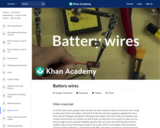
In this video we upgrade Bit-zee' battery wires from 32 gauge to 18 gauge. Created by Karl Wendt.
- Subject:
- Applied Science
- Engineering
- Material Type:
- Lesson
- Provider:
- Khan Academy
- Provider Set:
- Khan Academy
- Author:
- Karl Wendt
- Date Added:
- 10/08/2012

In this video we upgrade Bit-zee' battery wires from 32 gauge to 18 gauge. Created by Karl Wendt.
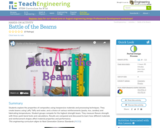
Students explore the properties of composites using inexpensive materials and processing techniques. They create beams using Laffy Taffy and water, and a choice of various reinforcements (pasta, rice, candies) and fabricating temperatures. Student groups compete for the highest strength beam. They measure flexure strength with three-point bend tests and calculations. Results are compared and discussed to learn how different materials and reinforcement shapes affect material properties and performance.
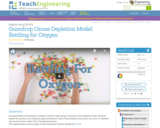
Using gumdrops and toothpicks, students conduct a large-group, interactive ozone depletion model. Students explore the dynamic and competing upper atmospheric roles of the protective ozone layer, the sun's UV radiation and harmful human-made CFCs (chlorofluorocarbons).
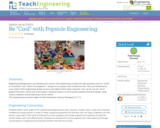
Beginning kindergarteners are introduced to science and engineering concepts through questions such as “What is a Scientist?” and “What is an Engineer?”, and go on to compare and contrast the two. They are introduced to five steps of the engineering design process and explore these steps using the “I do, we do, you do” set of guided instruction. At the end of the project, students produce a set of purple popsicles that they design using various materials and by following a set of criteria.

In this activity, students learn about their heart rate and different ways it can be measured. Students construct a simple measurement device using clay and a toothpick, and then use this device to measure their heart rate under different circumstances (i.e., sitting, standing and jumping). Students make predictions and record data on a worksheet.

Lighting is responsible for nearly one-third of the electricity use in buildings. One of the best ways to conserve energy is to make sure the lights are turned off when no one is in a room. This process can be automated using motion sensors. In this activity, students explore material properties as they relate to motion detection, and use that knowledge to make design judgments about what types of motion detectors to use in specific applications.

The true, inspiring story of Beauty, the bald eagle, who was shot, rescued, and received a 3D-printed prosthetic beak. The resource includes a lesson plan/book card, a design challenge, and copy of a design thinking journal that provide guidance on using the book to inspire students' curiosity for design thinking. Maker Challenges: (1) Use paper and pencil to design a prosthetic body part for a human or animal. Then use tinkercad.com to create a prototype. Finally, use a 3D printer to print the prosthetic. (2) Have students research animals who use prosthetics. Then, improve the design in Tinkercad and 3D Print.
A document is included in the resources folder that lists the complete standards-alignment for this book activity.
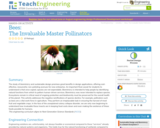
The study of biomimicry and sustainable design promises great benefits in design applications, offering cost-effective, resourceful, non-polluting avenues for new enterprise. An important final caveat for students to understand is that once copied, species are not expendable. Biomimicry is intended to help people by identifying natural functions from which to pattern human-driven services. Biomimicry was never intended to replace species. Ecosystems remain in critical need of ongoing protection and biodiversity must be preserved for the overall health of the planet. This activity addresses the negative ramifications of species decline. For example, pollinators such as bees are a vital work force in agriculture. They perform an irreplaceable task in ensuring the harvest of most fruit and vegetable crops. In the face of the unexplained colony collapse disorder, we are only now beginning to understand how invaluable these insects are in keeping food costs down and even making the existence of these foods possible for humans.
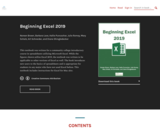
This Beginning Excel textbook is intended for use in a one-term introductory spreadsheet course for all majors taught at two-year colleges. The basics of Excel, as they apply to the professional workplace, are introduced, including spreadsheet design, data entry, formulas, functions, charts, tables, and multi-sheet use. This textbook includes instructions for Excel for Mac also.
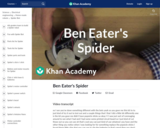
In this video Karl talks to Ben Eater about his improvements to the Spider bot platform. Created by Karl Wendt.
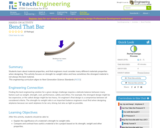
Students learn about material properties, and that engineers must consider many different materials properties when designing. This activity focuses on strength-to-weight ratios and how sometimes the strongest material is not always the best material.
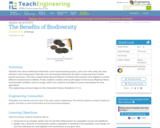
Students toss coins to determine what traits a set of mouse parents possess, such as fur color, body size, heat tolerance, and running speed. Then they use coin tossing to determine the traits a mouse pup born to these parents possesses. Then they compare these physical features to features that would be most adaptive in several different environmental conditions. Finally, students consider what would happen to the mouse offspring if those environmental conditions were to change: which mice would be most likely to survive and produce the next generation?
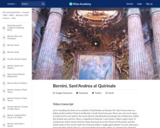
This art history video discussion looks at Gian Lorenzo Bernini's "Sant'Andrea al Quirinale", 1658-70, Rome; commissioned by Cardinal Camillo Francesco Maria Pamphili for the nearby Jesuit seminary.
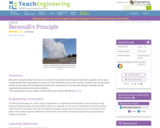
Bernoulli's principle relates the pressure of a fluid to its elevation and its speed. Bernoulli's equation can be used to approximate these parameters in water, air or any fluid that has very low viscosity. Students learn about the relationships between the components of the Bernoulli equation through real-life engineering examples and practice problems.
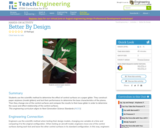
Students use the scientific method to determine the effect of control surfaces on a paper glider. They construct paper airplanes (model gliders) and test their performance to determine the base characteristics of the planes. Then they change one of the control surfaces and compare the results to their base glider in order to determine the cause and effect relationship of the control surfaces.
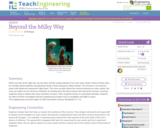
When we look at the night sky, we see stars and the nearby planets of our own solar system. Many of those stars are actually distant galaxies and glowing clouds of dust and gases called nebulae. The universe is an immense space with distances measured in light years. The more we learn about the universe beyond our solar system, the more we realize we do not know. Students are introduced to the basic known facts about the universe, and how engineers help us explore the many mysteries of space.
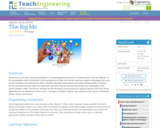
Momentum is not only a physical principle; it is a psychological phenomenon. Students learn how the "Big Mo" of the bandwagon effect contributes to the development of fads and manias, and how modern technology and mass media accelerate and intensify the effect. Students develop media literacy and critical thinking skills to analyze trends and determine the extent to which their decisions may be influenced by those who manipulate a few opinion leaders. Note: The literacy activities for the Mechanics unit are based on physical themes that have broad application to our experience in the world concepts of rhythm, balance, spin, gravity, levity, inertia, momentum, friction, stress and tension.
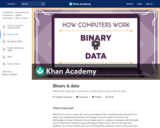
Adafruit founder Limor Fried and program manager Federico Gomez Suarez explain how computers represent numbers, text, images, and sound using tiny electric signals.
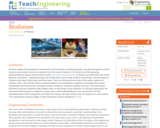
Students explore the biosphere's environments and ecosystems, learning along the way about the plants, animals, resources and natural cycles of our planet. Over the course of lessons 2-6, students use their growing understanding of various environments and the engineering design process to design and create their own model biodome ecosystems - exploring energy and nutrient flows, basic needs of plants and animals, and decomposers. Students learn about food chains and food webs. They are introduced to the roles of the water, carbon and nitrogen cycles. They test the effects of photosynthesis and transpiration. Students are introduced to animal classifications and interactions, including carnivore, herbivore, omnivore, predator and prey. They learn about biomimicry and how engineers often imitate nature in the design of new products. As everyday applications are interwoven into the lessons, students consider why a solid understanding of one's environment and the interdependence within ecosystems can inform the choices we make and the way we engineer our communities.
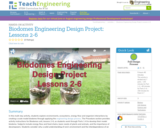
In this multi-day activity, students explore environments, ecosystems, energy flow and organism interactions by creating a scale model biodome, following the steps of the engineering design process. The Procedure section provides activity instructions for Biodomes unit, lessons 2-6, as students work through Parts 1-6 to develop their model biodome. Subjects include energy flow and food chains, basic needs of plants and animals, and the importance of decomposers. Students consider why a solid understanding of one's environment and the interdependence of an ecosystem can inform the choices we make and the way we engineer our own communities. This activity can be conducted as either a very structured or open-ended design.